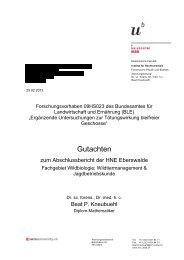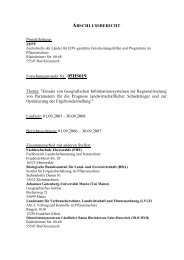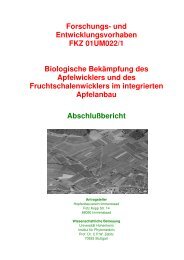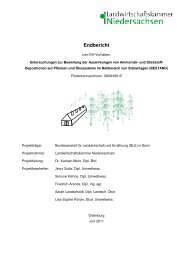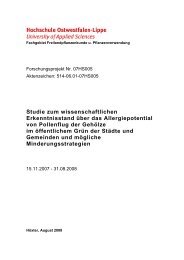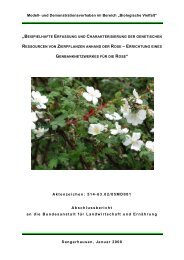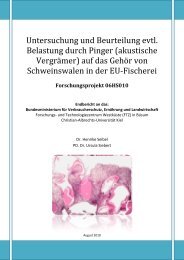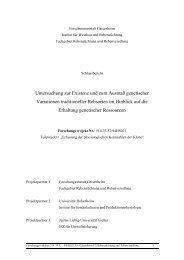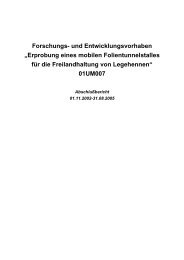Abschlussbericht Projekt: „Verminderung der ... - BLE
Abschlussbericht Projekt: „Verminderung der ... - BLE
Abschlussbericht Projekt: „Verminderung der ... - BLE
Sie wollen auch ein ePaper? Erhöhen Sie die Reichweite Ihrer Titel.
YUMPU macht aus Druck-PDFs automatisch weboptimierte ePaper, die Google liebt.
were performed in tubers after harvest and in tubers stored for five and eight months, respectively,<br />
at 4°C and 95 % relative humidity. Moreover, the tubers were divided into six<br />
groups of specific gravity ranking from 1.095 kg L -1 , with 0.01 increments. The<br />
separation was performed directly before testing (Wright et al. 2005). For this purpose tubers<br />
were plunged in different vessels with demineralised water and adequate NaCl- concentrations,<br />
respectively. Furthermore, the samples were divided into two parts. Tubers<br />
from the first part were used to determine their blackspot index (BSI). Tubers from the<br />
second part were used for analysis. Samples were sliced and used fresh or were shockfrozen<br />
in liquid nitrogen and stored at -30 °C until testing or freeze-drying (Epsilon 2-40,<br />
Christ).<br />
Analyses. Blackspot index (BSI) of whole potato tubers of different specific gravities was<br />
determined according to the method of the German “Bundessortenamt” (BSA) (Fe<strong>der</strong>al<br />
Plant Variety Office). The tubers were cooled down to 4 to 5°C and mechanical treated for<br />
50 s in a vegetable washing machine with a rotating drum (Flottwerk H.J. Dames GmbH &<br />
Co. KG, Rotenburg a. d. F., Germany) with three replications. Each replication consisted<br />
of an amount of tubers (Σ tuber ) adequate to a volume of 6 L. Afterwards, treated tubers were<br />
stored at room temperature for 48 hours. For BSI determination they were cut into halves<br />
length-wise and a half tuber was evaluated visually using a scale with four scores of discolouration:<br />
No discolouration indicated no blackspot development and therefore no<br />
blackspot bruise susceptibility (Σ 1 ). Discolouration till quarter of length and less than 5<br />
mm in-depth showed slight blackspot bruise susceptibility (Σ 2 ). Medium blackspot bruise<br />
susceptibility corresponded to a discolouration till quarter of length and above 5 mm indepth<br />
or a half of the length and maximal 5 mm in-depth (Σ 3 ). Serious blackspot bruise<br />
susceptibility was indicated by a stronger discolouration (Σ 4 ). The blackspot bruise susceptibility,<br />
expressed as the percentage of discoloured tubers was calculated from following<br />
equation (1):<br />
( ) ( 0.3∑ + 0.5∑ + ∑ )/<br />
∑<br />
BSI % =<br />
2 3 4 tuber*<br />
100<br />
(1)<br />
BSI: blackspot index (%)<br />
Σ: amount of analysed tubers<br />
The dry matter concentration of potato tubers was analysed according to Naumann and<br />
Bassler (1976). Starch analyses referred to the ICC- Standard method no. 123/ 1 (2006).<br />
The pectin concentrations of potato tubers were analysed in potato tuber peri<strong>der</strong>m, nonperi<strong>der</strong>m<br />
as well as in whole tubers differing in their specific gravity. Samples were prepared<br />
from fresh shock-frozen tissues. First of all the extraction of the ethanol insoluble cell<br />
wall material has taken place with 60 g sliced tissue (tissue fresh ), which was mixed with<br />
denatured ethanol using an ultra-turrax (Janke & Kunkel, IKA lab technics, Germany) (Keijbets<br />
and Pilnik 1974). Two grams of the degreased ethanol insoluble cell wall material<br />
(tissue degreased ) were cleaned up form starch using cold demineralised water and a nylon<br />
196




